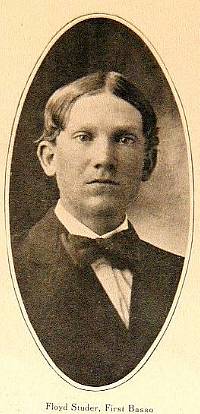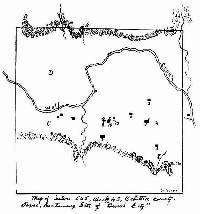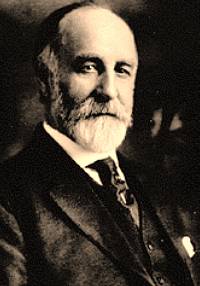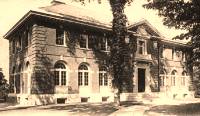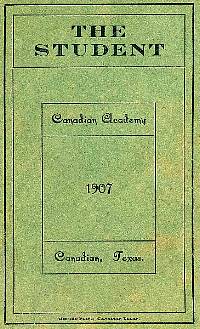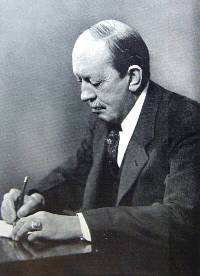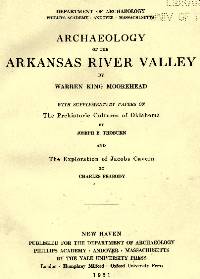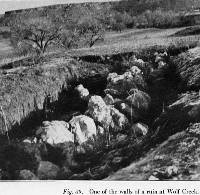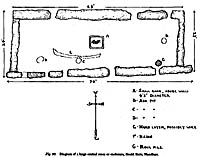
Moorehead's plan of the Gould Ruin,
also known as Eyerly's Temple. From Moorehead, 1931. |
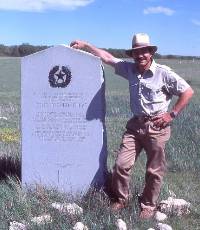
Tom Ellzey grew up on a ranch along
Wolf Creek. As a graduate student at the University
of Texas at Austin in mid-1960s, Ellzey carried out
additional explorations at the Handley Ruin identified
by Moorehead. The granite historical marker for Buried
City seen in this picture is apparently located on the
Handley Ruin. Unfortunately, the results of Ellzey's
work have never been fully reported. Photo by Chris
Lintz.
|
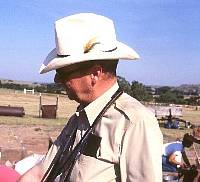
Landowner Harold Courson at the 1987
TAS field school at Buried City.
|
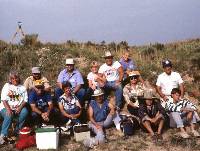
TAS crew in 1987.
|

Excavation of a pithouse underway
in the Courson D area at Buried City in August, 2003.
Photo by David Hughes.
|

Pithouse excavated in August, 2003
at the Courson D site in the Buried City settlement
zone by the University of Oklahama. The feature identifications
are clearly labeled. Photo and graphic by Scott Brosowske.
|
|
Although his Arkansas River Valley explorations
were completed in 1921, Moorehead was soon distracted by work
at several major mound sites including Cahokia and Etowah,
and the results of his investigations of the Buried City languished
until 1931 when his Archeology of the Arkansas River Valley
was published. He remained at Phillips Academy until his retirement
in 1938, shortly before his death. Moorehead is said to have
been a sensitive and retiring person who took great umbrage
at perceived (or actual) slights and professional criticisms.
In an era of growing professionalization of the discipline
of archeology, Warren King Moorehead was one of the last of
the "old school" of 19th century, self-trained archeologists.
The friendly relations between Studer, also
a largely self-taught archeologist, and Moorehead continued
for many years after completion of these early investigations.
Correspondence between them suggests that Moorehead may have
played a significant role in encouraging Studer's participation
in the founding of the Panhandle-Plains Historical Museum.
Studer continued his interest in archeology through this new
forum and was instrumental in arranging Works Progress Administration
excavation of many archeological sites in the Texas Panhandle
through the 1930s.
The creation of Lake Fryer on Wolf Creek
not far downstream from Buried City in 1938 undoubtedly destroyed
many Plains Village houses. The area was not studied prior
to its inundation.
Following Moorehead's investigations, no archeological
research was carried out along Wolf Creek until the mid-1960s
when Tom Ellzey, who had been raised on Wolf Creek
and was then a graduate student at the University of Texas,
undertook to explore the Handley Ruin identified by Moorehead.
Ellzey's investigations were conducted because of his interest
in the area and increasing interest in anthropology and archeology
as a profession. He also recorded several other sites in the
immediate vicinity. No final report of Ellzey's investigations
has ever been published.
Sam Handley (who sometimes spelled
his name Handly) had owned the Buried City since the early
part of the nineteen-teens. During the past few decades of
his life (1950s and 1960s), Handley opened his ranch on Wolf
Creek to the public. For a small daily fee, local people could
come picnic, fish, and hunt or dig for artifacts. As a result,
virtually all of the house ruins obvious on the surface were
dug into repeatedly and many artifacts were removed.
In the early 1980s Perryton resident and
oil man Harold Courson purchased the old Handley Ranch,
including the Buried City and related archeological sites,
from the estate of Sam Handley. One of the reasons Courson
purchased the property was that he knew of its significance
and the local awareness of its importance and, paraphrasing
his own words, he wanted to give something back to the county
that had given so much to him. Harold Courson and son L. Kirk
Courson devised a development plan for the ranch's livestock,
renovation of its historic structures, and archeological investigation.
In 1985, Kirk Courson called archeologist David Hughes (author of this exhibit) to inquire about salvaging two Buried
City sites that were rapidly eroding into Wolf Creek on the
newly acquired ranch. (Each of the major concentrations of
ruins are now considered separate sites.) Hughes began investigation
of sites, dubbed Courson A and Courson B, in the summer of
1985 with a small professional crew supplemented by Perryton
High School students. Because of the size of the effort and
the potential remaining in Buried City studies, the Courson
family invited Hughes back in 1986 and a more comprehensive
investigation was begun to complete the work at Courson B and
expose the house at Kit Courson, a third locality.
Because of public interest and the archeological
potential discovered in these heavily disturbed sites, the
Courson family and Hughes invited the Texas Archeological
Society (TAS) to hold their field school at the Buried City
in 1987 and 1988. Hundreds of volunteers from all over Texas
and many surrounding states came to the Wolf Creek Valley
to help secure information about this unique archeological
area. TAS investigations completed the work at Courson A,
Courson B, the Kit Courson Site, two additional localities,
Courson C and Courson D, and began new explorations of "Eyerly's
Temple," the structure Moorehead called the Gould Ruin.
The final major field season Hughes directed
was in the summer of 1990 when Wichita State University held a 3-month field school to complete preliminary evaluation
of the unusual Eyerly's Temple in the original Buried City
site area.
Analysis of these findings and preparation of
the reports is continuing under the direction of Hughes at
Wichita State University in Wichita, Kansas. When all analysis
is completed, all collections and photographs will be returned
to the Courson family who plans to make the information available
through a public museum and interpretation in the area.
In 2000, a new round of investigations at Buried
City began under the direction of Scott Brosowske,
a Ph.D. student at the University of Oklahoma. Brosowske was
invited by the Courson family to carry out geophysical survey
work along Wolf Creek to search for buried structural remains.
A consulting firm, Archaeophysics LLC, carried out the survey
using several different sensing devices including a soil resistance
meter, a gradiometer, and a ground penetrating radar. Each of these devices detects anomalies
(irregularities) in the soil such as those caused by the excavation
of pits, fired surfaces, and buried rock alignments. Among
the numerous anomalies were many the team thought were likely
the signatures of cultural patterns, such as trash pits and
pithouses.
The following year (2001), Brosowske, aided
by avocational archeologists, began to "ground truth"
the geophysical data, meaning they began to sink test pits
in and around the anomalies they felt were most promising.
The initial results were very encouraging, but the need for more extensive excavation was
obvious. So in the summer of
2003, Brosowske and fellow University of Oklahoma archeologist
Susan C. Vehik returned to the area with an archeological
field school aided again by volunteer archeologists.
The Oklahoma team excavated two areas and in
both cases came down on deeply buried pithouses that look
very different from the stone-based houses built on the surface
that are considered typical of Buried City. The analysis is
just beginning, but the artifact assemblage seems to be very
similar to that found in the stone-based houses. In other words,
Plains Villagers were also living in pithouses. It is not
yet known whether, as Brosowske suspects, some of the pithouses
date a century or two earlier than the stone-based houses.
But what is obvious is that the history of the Buried City
settlement is much more complex and interesting than has been
known for almost a century.
|

Cordmarked jars from the Gould Ruin.
From Moorehead, 1931.
|
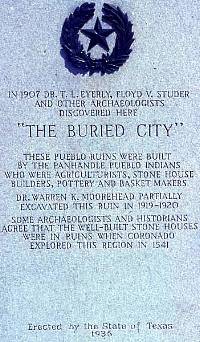
Buried City historical marker erected
by the State of Texas in 1936. Photo by Chris Lintz.
|

TAS members at work in 1987.
|
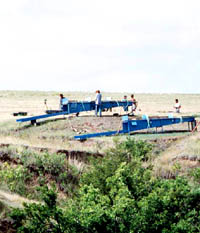
TAS crew water screening. This technique
allowed improved recovery of small bones and other tell-tale
evidence. Photo by David Hughes.
|
|
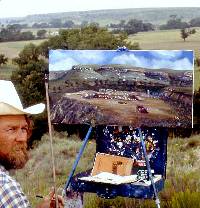
Artist Charles Becker painting scene
of TAS excavations in 1987. Photo by Wallace Williams. |
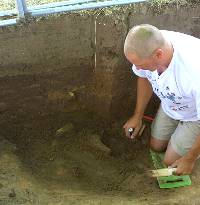
Scott Brosowske pauses to discuss
his excavation strategy. As the accompanying photo shows,
in this excavation area, a deeply buried pithouse was
found. Photo by David Hughes.
|
|
